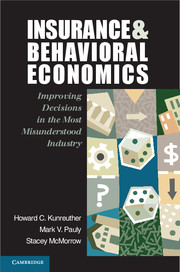Book contents
- Frontmatter
- Contents
- Preface
- Acknowledgments
- Part I Contrasting Ideal and Real Worlds of Insurance
- 1 Purposes of This Book
- 2 An Introduction to Insurance in Practice and Theory
- 3 Anomalies and Rumors of Anomalies
- 4 Behavior Consistent with Benchmark Models
- Part II Understanding Consumer and Insurer Behavior
- Part III The Future of Insurance
- Notes
- Glossary
- Bibliography
- Author Index
- Subject Index
1 - Purposes of This Book
Published online by Cambridge University Press: 05 February 2013
- Frontmatter
- Contents
- Preface
- Acknowledgments
- Part I Contrasting Ideal and Real Worlds of Insurance
- 1 Purposes of This Book
- 2 An Introduction to Insurance in Practice and Theory
- 3 Anomalies and Rumors of Anomalies
- 4 Behavior Consistent with Benchmark Models
- Part II Understanding Consumer and Insurer Behavior
- Part III The Future of Insurance
- Notes
- Glossary
- Bibliography
- Author Index
- Subject Index
Summary
Our goal in this book is to identify and analyze examples of behavior on the parts of consumers, insurance companies, investors, and regulators that could be characterized as “anomalous” if judged by standards of rational behavior. In this book, the term rationality is defined as economists have traditionally used it when analyzing decisions that involve risk and uncertainty. We characterize behavior as anomalous when it violates these standards.
Even though the economist’s notion of rationality is well established, it is not the only or even the best way to portray what people may mean by appropriate behavior. In fact, we ourselves often behave in ways that do not conform to these formal principles of rationality and can provide good reasons or excuses for these deviations. We and others (Cutler and Zeckhauser 2004; Kunreuther and Pauly 2006; Liebman and Zeckhauser 2008) have noted examples of behavior by consumers and suppliers of insurance that violate the economic models of rational choice.
The main message from the behavioral economics revolution is that real-world agents often do not make choices in the way that economic models of rationality suggest they should. In evaluating the results of such behavior and suggesting what strategies one should pursue, researchers still normally turn to the conventional economic models as normative benchmarks. For this reason, formal economic models of demand and supply developed over decades are often used as benchmarks for evaluating the behavior of those who are considering purchasing insurance and those who decide whether or not to offer coverage for specific risks.
- Type
- Chapter
- Information
- Insurance and Behavioral EconomicsImproving Decisions in the Most Misunderstood Industry, pp. 3 - 10Publisher: Cambridge University PressPrint publication year: 2013

